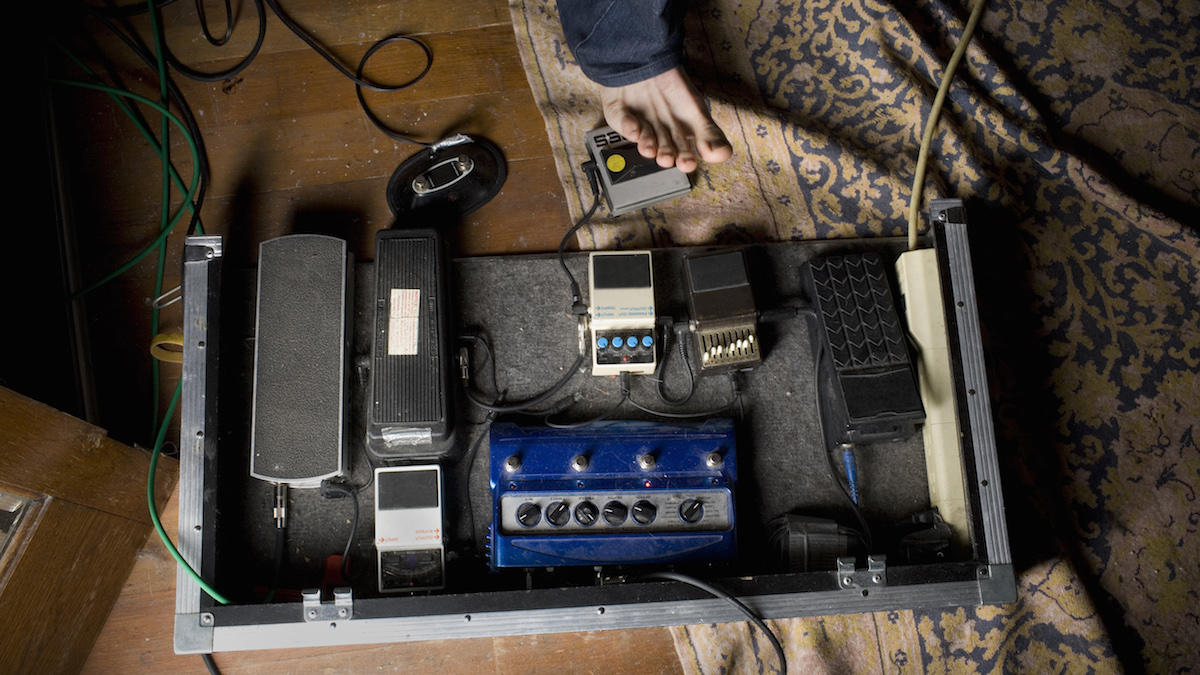True bypass vs buffered bypass: what’s the difference?
We lift the lid on the pros and cons of both, and the impact they can have on your guitar tone

It's easy to forget, but there was a time when pedal power requirements were often quite different. Some pedals took different voltages, connectors, or couldn't be daisy-chained with the now standard Boss/Roland center-negative 9V standard.
Just as power requirements standardized over time, so did approaches to bypassing pedals. Particularly in boutique circles, the true bypass circuit block became the de-facto standard, displacing many different ways of wiring 3PDT and DPDT switches used by different builders over the years. Not only that, but it started to push another technique out of fashion - the relay and buffered bypass used by large manufacturers.
That's all well and good, but you might be thinking to yourself, "what's so bad about buffered bypass anyway?" Well, the answer is that there are pros and cons to both. In this article, we're going to take you through them and answer the true bypass vs buffered bypass debate, so you can decide for yourself which is better in which situation.
True bypass explained

What is true bypass?
True bypass is simply any wiring scheme that means when a pedal is bypassed, or 'off', the signal path passes directly from input jack to output jack. There's a variety of ways of achieving this, but the general pattern tends to be similar. The object is that none of the pedal's sound - other than the jack connection and wire - is in the signal path unless the pedal is on.
This eliminates not only obvious issues like power-line noise and hum, but also more subtle things like interference caused by LEDs, LCD screens or clock noise. Crucially, a buffered bypass pedal keeps the buffer in the signal path whether the pedal is on, or bypassed.
True bypass: pros
Lower noise. Any noise that is normally not audible when notes are going through the circuit can be problematic when there is no signal passing. Some pedals have feedback loops that can lead to oscillation - think of fuzz pedals like the Z-Vex Fuzz Factory - and this noise could be introduced into the signal path if it wasn't true bypass.
Your tone is preserved. It's true to say that buffers affect the tone of your guitar. Depending on the buffer design, this might not be desirable, although it's worth saying that most buffers are almost completely transparent. The reason they change the sound is usually due to their interaction with cable capacitance, but we'll get onto that later.
Get The Pick Newsletter
All the latest guitar news, interviews, lessons, reviews, deals and more, direct to your inbox!
A genuine concern could be that some pedals don't sound as good with a buffer, or a buffered pedal in front of them. Generally this is due to the impedance that they expect being that of a guitar pickup, rather than a buffered pedal output.
This particularly affects older fuzzes, or boutique pedals like the Fuzz Factory that are descended from them.
Heavy duty switches. This one is probably a little bit overworn, in our experience. Underneath the hood of many relay-bypass pedals is a flimsy-looking switch, whereas many of even the cheapest 3PDT footswitches are not only tougher externally but may survive more usage cycles. Given that we own Boss pedals from the 80s that still work, however, we're inclined to not worry about this one too much.
True bypass: cons
Is your tone preserved? Obviously the bypassed pedal can't impact your sound any longer, but removing all buffers from your signal chain can be a much bigger issue. Cable capacitance means that lots of guitar cables, or long cable runs, can quickly kill the top-end of your signal. A buffer will combat this.
Switching noise. Those heavy-duty switches are a double-edged sword. They're physically loud when clicked, which means that if the circuit is microphonic in any way, you're likely to hear the click coming out of your amp.
Moreover, the way the main circuit is brought in and out of the signal chain quite often results in an audible 'pop' if there is any DC in the signal path. This can be mitigated using a pull-down resistor, but can be difficult to eliminate completely.
Anything else I should know?
Even a pedalboard of mostly true-bypass pedals isn't a silver bullet against signal noise. Pedals can interfere with one another - for example, an always-on guitar tuner out of your main signal path - and issues like ground loops and hum caused by poor wiring in the building or grounding issues can be beyond your power to resolve.
Buffered bypass explained

What is buffered bypass?
Buffered bypass is simply where part of the circuit stays in the signal path whether the main circuit of the pedal is active or not. This has some advantages - for example, it means you can implement tails on delays and reverbs, but at the cost of keeping certain parts of a circuit in the signal chain.
Another advantage is that you can keep a consistent output impedance for the pedals that follow, regardless of whether the main circuit is on or not. This can avoid changes in signal strength, and at worst, outright changes in the timbre of your clean signal.
Buffered bypass: pros
Buffer is always on, even when the pedal is off. A buffer presents a consistent output impedance to the pedals that follow. In practice this just means a more consistent level and signal strength.
Helps preserve tone with long cable runs. If you have long cable runs, or lots of pedals, then the capacitance of these adds up, resulting in roll-off of treble from your signal.
In this case, the benefit of true bypass - that you're "connecting straight from guitar to amp" is actually a drawback. Having a buffer in your chain mitigates this issue, resulting in a more stable and punchy-sounding signal.
Switching is quieter. Often due to the way that relay bypass is implemented, the switching is both physically quieter, and quieter in terms of signal noise.
Switch feel is often nicer. Controversially, we've always preferred the Boss and Ibanez style rubberized pads over 3PDT or DPDT type switches. Obviously you can get ultra-luxe switches in that form-factor that are buttery smooth. Unfortunately, they're expensive enough that few manufacturers use them.
Buffered bypass: cons
Buffer is always on, even when the pedal is off. Although most buffers are transparent, it's possible they can introduce signal noise to your chain.
Pedal order issues. Some pedals don't like coming after a buffer. This can usually be solved by changing pedal order, so it's a simple fix. Generally, a buffered distortion would probably be best as the final distortion or drive on your board.
Risk of introducing pedal noise to the chain even when off. This is a complex issue, because many different culprits can generate noise. However, it's generally the case that a non true bypass overdrive or distortion runs more risk of introducing noise to your signal chain.
In practice though, manufacturers are paranoid enough about this that it's not a problem we've ever had. Where we have had problems is instead with reverbs and delays. Often, because of how they implement tails, if there is any crosstalk, or power supply noise inherent in the pedal, it can then end up in your signal when the pedal is bypassed.
We've also had an issue where a buffered tremolo pedal introduced a ticking into our signal path in time with its clock. With a distortion after it, this became quite a big issue live.
Power supply woes. Due to being buffered, most pedals will only pass sound when powered, although some have different wiring layouts. If you happen to be using a battery with a true bypass pedal and the battery runs out, your signal won't cut out until you engage the pedal that's now unpowered. With a buffered bypass pedal, it'll likely cut your signal totally, as we once found out at a gig when we were younger.
Anything else I should know?
As alluded to above, the biggest noise issues we've ever had have been with tuners. Their large screens can sometimes introduce interference that's devilishly hard to track down and debug. In our case, the tuner was true-bypass, but left 'always on' from the tuner out of a pedal. This reiterates a perhaps obvious point - that even a true bypass pedal is always noisy to some extent when on!
Alex Lynham is a gear obsessive who's been collecting and building modern and vintage equipment since he got his first Saturday job. Besides reviewing countless pedals for Total Guitar, he's written guides on how to build your first pedal, how to build a tube amp from a kit, and briefly went viral when he released a glitch delay pedal, the Atom Smasher.











